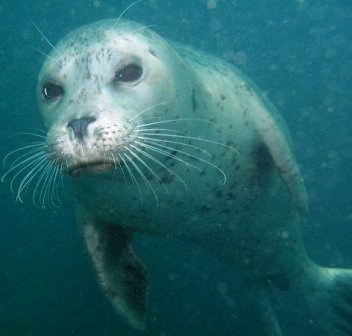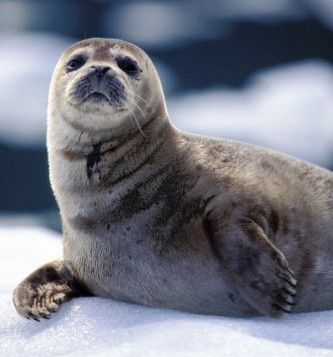Harbor seals (Phoca vitulina), are “true seals” of the Phocidae family, also sometimes called “common” or “hair” seals. They are covered with short, stiff, bristle-like hair. Coloration varies, but two basic patterns occur: light gray sides and belly with dark blotches or spots, or a dark background with light rings. They can be distinguished from other pinnipeds such as fur seals and sea lions by the absence of external ear flaps; only a small hole (the external pinnae, or opening to the ear canal) is visible on either side of their head. When on land, harbor seals move awkwardly by undulating in a caterpillar-like motion because their pelvic bones are fused preventing them from moving their hind flippers under their pelvis to walk. In the water they are graceful and efficient swimmers, using their fore flippers as rudders and their hind flippers for propulsion by clasping both hind flippers together, splaying webbed toes and moving the large hind flippers side to side.
Harbor seals weigh about 24 pounds at birth and gain weight rapidly during a month-long suckling period; perhaps doubling their weight. They can reach five to six feet in length. Average weight for adults is about 180 pounds (82 kg); males are somewhat larger than females and can weigh up to 285 pounds,
Harbor seals are well adapted to life in the sea. They are able to dive to depths up to 1640 feet (500m) and can remain submerged for over 20 minutes, although most dives are less than 65ft (20m) and less than 4 minutes long. Oxygen-conserving adaptations that allow such dives include high blood volume, reduced peripheral circulation, reduced heart rate, and high levels of myoglobin (oxygen-binding protein in muscle). Harbor seals haul out of the water periodically to rest, give birth, and nurse their pups. In winter seals spend up to 80% of their time in the water. In spring and summer they spend more time hauled out during pupping and molt season. Harbor seals molt annually, usually in summer; timing of molt depends upon sex and age class.
In Alaska, single pups are born between May and
mid-July. Young pups are able to swim almost immediately
after birth. They normally remain with their mothers
about one month, after which they are weaned and
separate from their mother. At that time over half their
body weight may consist of fat, providing them a head
start on self-sufficiency. Sexual maturity occurs at
between 3 and 7 years. Mature females mate shortly after
weaning their pups. Development of the embryo is
suspended for about 11 weeks; a trait called embryonic diapause (i.e., delayed implantation). Active fetal development is about 8½ months. Births of harbor seal pups are not restricted to a few major rookeries (as is the case for many species of pinnipeds) but occur at many haul-out sites. The sex ratio of harbor seals at birth is approximately equal and remains so until about 5 years of age. Thereafter mortality rates for males are higher, and females become relatively more abundant. Maximum ages estimated from annual rings in their teeth are 26 years for a male and 35 years for a female.
Harbor seals are opportunistic feeders and likely take advantage of seasonally available prey resources. In Alaska, commonly eaten prey include walleye pollock, Pacific cod, capelin, eulachon, Pacific herring, sandlance, Pacific salmon, sculpin, flatfish (e.g., flounder and sole), octopus, and squid.
Harbor seals show variable movement patterns depending on their sex and age class, with some exhibiting considerable localized travel, but no seasonal patterns, while others show more extended movements, particularly during the winter.
Harbor seals are usually solitary in water, but haul out in groups of a few to thousands. When they are in the water and not feeling threatened, they are inquisitive but elusive, often surfacing close behind boats. Because they move awkwardly on land, when they are hauled out they are quick to enter the water if they feel threatened, even when aquatic predators are present.
The harbor seal, is a widespread species in both the north Atlantic and Pacific oceans, and is found in Alaska along the coast extending from Dixon Entrance north to Kuskokwim Bay and west throughout the Aleutian Islands. Reefs, sand and gravel beaches, sand and mud bars, and glacial, pan ice, and sea ice are commonly used for haul-out sites. Harbor seals are sometimes found in rivers and lakes, usually on a seasonal basis (present in summer, absent in winter). At Iliamna Lake, seals are present year-round and are probably resident.
The total Alaska harbor seal population is estimated at
approximately 141,000 in non-glacial sites and
approximately 15,000 in glacial fjords. Harbor seals are
difficult to census because they can only be accurately
counted when they are hauled out. They haul out at
different times of the day at thousands of locations in
Alaska; both at terrestrial sites and on glacial ice
calved from tidewater glaciers.
|
|








